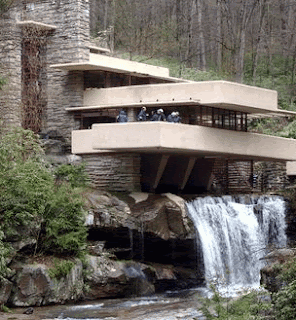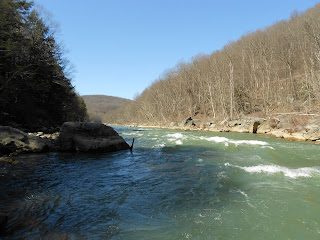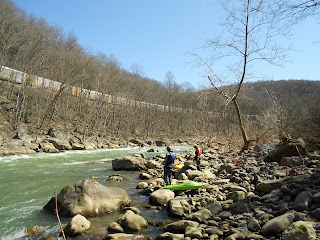I doubt Robert Frost ever spent much time in Western Pennsylvania, particularly the outdoor playground known as the Laurel Highlands. But last Sunday, on the first magnificent day of spring (even though it was a few days shy of the vernal equinox) half of the Mid-Atlantic states seemed to be out and about in Ohiopyle, the region’s recreational nexus.
Although fewer than 100 souls call Ohiopyle home the year ‘round (the 2000 census pegged the population at 77), the hamlet swells to many, many times that size on the weekends in the spring, summer and fall. A few miles north of town, Fallingwater’s world-renowned beige and Cherokee red cantilevers hang suspended over Bear Run; a few miles south of town Frank Lloyd Wright’s lesser-known Kentuck Knob is perched near the top of a hill overlooking the rounded mountains surrounding Ohiopyle, including the gorge of the Youghiogheny River – aka The Yough.
There are certainly more savage rivers in the United States, but none see more white water rafting than the Yough. Even when the water is running high and swift – as it was last weekend – the rapids on the two mile stretch below the falls of the Youghiogheny (overlooked by Ohiopyle itself) are tailor-made for kayakers and rafters of all shapes, sizes and experience levels. At least half a dozen commercial outfitters ply its waters, giving neophyte river runners a thrill or three, while scores of experienced kayackers delight playing in Cucumber, Railroad, Dimple and Double Hydraulic rapids . . . although a summer seldom passes that some unfortunate soul doesn’t drown after being tossed from his craft and getting stuck beneath the school bus-sized boulder that gives Dimple Rapids its name.
While the Yough has been drawing white water adventurers and entrepreneurs for half a century, Ohiopyle has only recently become a bicycling magnet. These days scores of cyclists use Ohiopyle as the jumping off point for a day trip along one of the most scenic stretched of the Great Allegheny Passage bike path that stretches from Pittsburgh to Cumberland, MD, where it connects with the C&O Canal Towpath and on to Washington DC.
The path, which utilizes the abandoned railbed of the Western Maryland Railroad, parallels the Yough as it executes a nearly 360 degree loop downstream from Ohiopyle. Along some stretches the bike path also utilizes (or usurps depending on one’s perspective) a network of footpaths paralleling the river.
So it was that, on the first morning of DST, I set out on a Great Gorge hiking trail that sometimes runs in tandem with and “under” the bike path from its origins near the thundering falls of Cucumber Run down to Jonathan and Sugar Runs.
For much of the way, the Great Gorge path is delightfully easy walking, as it uses the railroad bed, with its wide, gentle and rock- and tree root-free gentle grades pleasantly meandering through a forest of pines and hardwood, with occasional rivulets plunging down the hillside towards the jade green Youghiogheny.
About a mile into the trip though, a substantial bridge hoves into view on the right, one utilizing the weather-beaten pillars of an old railroad trestle connecting a spur to this mainline and now reborn as a foot/bicycle bridge for the Great Allegheny Passage. Here you are presented with a Frost-like conundrum – take the bike path, a veritable forest freeway of crushed stone, gravel and sand, or the uneven, unpaved and less traveled Beech Trail climbing the slope above.
It took me but a moment to select the Beech Trail, with its slightly more challenging nature and decidedly more intimate character. Like the Great Gorge trail before it, the Beech Trail contours along the hillside, sometimes dipping under craggy outcrops, other times winding back along bubbling, rhododendrum-choked rills and, eventually, climbing to the point where stream crossings are better accomplished with a hop, skip and a jump than a costly bridge or culvert.
Eventually, however, the Beech Trail goes the way of the Great Gorge Trail, dropping to the level of, and merging with, the Great Allegheny Passage. So be it. Having seen just six people – and two dogs – on the bike path in the first two hours of my hike, it wasn’t like I was thrust into rush hour traffic upon joining the path more often taken.
In fact I only saw one other soul – a cheerful woman cruising past on a mountain bike – over the next mile or so, before I followed some wooden steps down towards the river and made my way to a rocky beach alongside Dimple Rapids.
Although I initially had the place to myself, I was soon joined by a rod-less fisherman, scouting the site for a planned visit with his grandson some future weekend. And before long, one, two, three and, finally, oodles of kayakers paddled past, frolicking in the hydraulics before heading downstream to Swimmers, Schoolhouse rapids and the Yough’s rendezvous with Bear Run. Several so enjoyed the experience, they paddled to shore, clambored from their kayaks and executed a gingerly portage along the rocky shore in their wet-suit moccasins only to button-back-up in their coffin-sized vessels and do it all over again.
Before long, a low rumble announced the approach of a train. Sure enough, a pair of diesel locomotives appeared across the river trailing a mile-long string of coal-laden hopper cars destined for the fossil fuel-fired power plants of the Midwest and what remains of Pittsburgh’s steel industry.
Before long, a low rumble announced the approach of a train. Sure enough, a pair of diesel locomotives appeared across the river trailing a mile-long string of coal-laden hopper cars destined for the fossil fuel-fired power plants of the Midwest and what remains of Pittsburgh’s steel industry.
When it comes to Ohiopyle, the Youghiogheny and the Laurel Highlands, it seems there’s no end to the transportation options – be it trains, automobiles, kayaks, rafts, bicycles or the shoe leather express. What’s more, sometimes those of us using the latter can have our cake and eat it too: On the “back” part of my ‘out ‘n back hike,’ rather than retrace my steps along the Beech Trail, I stuck with the bike path and got the best of both worlds from my outing . . . even if Mr. Frost is rolling over in his grave!








